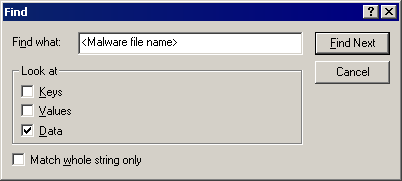BKDR_SMALL.JK
Windows 2000, Windows XP, Windows Server 2003


Threat Type: Backdoor
Destructiveness: No
Encrypted: No
In the wild: Yes
OVERVIEW
This backdoor may be downloaded by other malware/grayware/spyware from remote sites. It may be dropped by other malware. It arrives as a component bundled with malware/grayware packages. It may be unknowingly downloaded by a user while visiting malicious websites.
It deletes the initially executed copy of itself.
TECHNICAL DETAILS
49,152 bytes
EXE
No
21 Aug 2011
Arrival Details
This backdoor may be downloaded by other malware/grayware/spyware from remote sites.
It may be dropped by other malware.
It arrives as a component bundled with malware/grayware packages.
It may be unknowingly downloaded by a user while visiting malicious websites.
Installation
This backdoor drops the following files:
- %System%\{net service name}ssvcs.dll - also detected as BKDR_SMALL.JK
(Note: %System% is the Windows system folder, which is usually C:\Windows\System on Windows 98 and ME, C:\WINNT\System32 on Windows NT and 2000, or C:\Windows\System32 on Windows XP and Server 2003.)
Autostart Technique
This backdoor registers itself as a system service to ensure its automatic execution at every system startup by adding the following registry entries:
HKEY_LOCAL_MACHINE\SYSTEM\CurrentControlSet\
Services\{net service name}
Type = 20
HKEY_LOCAL_MACHINE\SYSTEM\CurrentControlSet\
Services\{net service name}
Start = 2
HKEY_LOCAL_MACHINE\SYSTEM\CurrentControlSet\
Services\{net service name}
ErrorControl = 1
HKEY_LOCAL_MACHINE\SYSTEM\CurrentControlSet\
Services\{net service name}
ImagePath = %System%\svchost.exe -k netsvcs
HKEY_LOCAL_MACHINE\SYSTEM\CurrentControlSet\
Services\{net service name}
DisplayName = {net service name}
HKEY_LOCAL_MACHINE\SYSTEM\CurrentControlSet\
Services\{net service name}
ObjectName = LocalSystem
HKEY_LOCAL_MACHINE\SYSTEM\CurrentControlSet\
Services\{net service name}\Parameters
ServiceDll = %System%\{net service name}ssvcs.dll
Other Details
This backdoor deletes the initially executed copy of itself
NOTES:
It queries the registry below to get a list of net services and uses one of them as its service name:
HKEY_LOCAL_MACHINE\SOFTWARE\Microsoft\Windows NT\CurrentVersion\Svchost
netsvcs
It then creates its component DLL file using this net service name:
- %System%\{net service name}ssvcs.dll
This backdoor listens to the TCP port 1431. However, during testing, it was unable to resolve the correct IP address for its C & C server. If connection is successful, this backdoor has the capability of executing shell commands via command line.
SOLUTION
9.200
Step 1
For Windows XP and Windows Server 2003 users, before doing any scans, please make sure you disable System Restore to allow full scanning of your computer.
Step 2
Restart in Safe Mode
Step 3
To delete the random service key this malware/grayware created:
- Scan your computer with your Trend Micro product and take note of the name of the malware/grayware/spyware detected.
- Open Registry Editor. To do this, click Start>Run, type regedit in the text box provided, then press Enter.
- Press CTRL+F.
- In the Find dialog box, type the file name of the malware detected earlier.
(Note: Make sure that only the data checkbox is selected, then click Find Next.) - Once found, in the right panel, check if the result is the following value-data pair:
ImagePath = {malware/grayware path and file name} - If yes, in the left panel, locate the service where the data is under.
- Right-click on the located service in the left panel and choose Delete.
- Repeat steps 2 to 6 until the Finished searching through the registry dialog box appears.
- Close Registry Editor.

Step 4
Restart in normal mode and scan your computer with your Trend Micro product for files detected as BKDR_SMALL.JK. If the detected files have already been cleaned, deleted, or quarantined by your Trend Micro product, no further step is required. You may opt to simply delete the quarantined files. Please check this Knowledge Base page for more information.
NOTES:
In Step 3, check if the result is the following value-data pair instead:
- ServiceDll = {Malware/Grayware/Spyware path and file name}
Did this description help? Tell us how we did.

